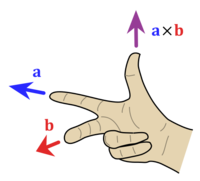Right Hand Rule
 From Conservapedia
From Conservapedia In physics, the right hand rule is a technique used to find the resultant direction of a cross product. Its name comes from the fact that, by convention, Cartesian coordinates are defined as "right handed", and the rule therefore requires that the right hand be used to get the correct result.
Examples[edit]

Direction of the magnetic force on a particle[edit]
To find the direction of the magnetic force on a positively charged particle in a magnetic field, hold your right hand in a "thumbs up" position. Now, keeping your thumb extended, point your index finger in the direction of the particle's velocity. Your hand should now look as if you are forming a "gun." Next, keeping your index finger pointing in the same direction, extend your middle finger so that it forms a 90 degree angle with your index finger. Rotate your hand about the axis formed by your index finger so that your middle finger points in the direction of the magnetic field. Your thumb now points in the direction of the magnetic force.
Note that if the particle were negatively charged, you can still use the right hand rule, but the force is in the opposite direction (180 degrees away) from the force on the positive particle.
Direction of the magnetic field generated by a current-carrying wire[edit]
To determine the orientation of the magnetic field caused by a current-carrying wire, point your right thumb in the direction of the current, as if the current is running "through" your thumb. Keeping your thumb in that orientation, curl your fingers around the wire. The magnetic field follows the circular path of your fingers.
Categories: [Physics]
↧ Download as ZWI file | Last modified: 02/16/2023 16:16:38 | 3 views
☰ Source: https://www.conservapedia.com/Right_hand_rule | License: CC BY-SA 3.0
 ZWI signed:
ZWI signed:
 KSF
KSF